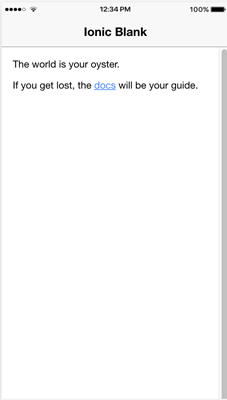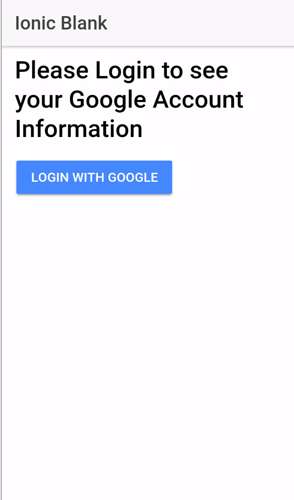This is step by step tutorial Ionic 3 and Angular 4 app authentication
with Ionic 3 native Google plus plugin. Before started with the app,
there's a setup of Google Plus via Google Developer Console.

5. Run Ionic 3 App on Android and iOS Device

1. Google API Setup
The first thing to setup from Google is generating configuration files
for iOS and Android. For iOS, open your browser then point to this address then log in with your google account.
Create the new iOS app from there by filling the form. Enter app name
and iOS bundle ID, our example is "MyGooglePlusAuth" for app name and
"com.mygoogleplusauth" for iOS bundle ID. Please, remember that iOS
bundle ID will use in Ionic 3 config later and that would be easy if we
use the same bundle ID for Android.
Leave other option to default then click "Choose and Configure Service" button.
Click "ENABLE GOOGLE SIGN IN" button. After that, click "Generate
configuration file" button. Click the button "Download
GoogleService-info.plist", we will use this files later on the Ionic 3
project.
Next, we have to generate Google service configuration file for Android too. Go to this address then choose app name that previously created. File Android package name same as iOS bundle ID "com.mygoogleplusauth".
Click "Choose and configure service" button. Before enabling this
service, we have to create new SHA-1 signing certificate which uses for
release and debug. Open terminal or command line, then type this command
to create certificate fingerprint for debugging.
keytool -exportcert -list -v \
> -alias androiddebugkey -keystore ~/.android/debug.keystore
or from the command line (windows).
keytool -exportcert -list -v \
-alias androiddebugkey -keystore %USERPROFILE%\.android\debug.keystore
Enter the password, by default for "debug.keystore is "android".
Alias name: androiddebugkey
Creation date: Nov 8, 2015
Entry type: PrivateKeyEntry
Certificate chain length: 1
Certificate[1]:
Owner: CN=Android Debug, O=Android, C=US
Issuer: CN=Android Debug, O=Android, C=US
Serial number: 5e9752f4
Valid from: Sun Nov 08 22:25:34 WIB 2015 until: Tue Oct 31 22:25:34 WIB 2045
Certificate fingerprints:
MD5: 0A:2D:96:6B:B8:84:F7:37:2E:7E:83:09:43:BB:B7:D4
SHA1: 2B:52:02:F0:82:94:34:68:FC:B6:DD:81:1D:3A:66:D7:57:3B:B9:11
SHA256: B1:40:EB:9D:03:50:A2:0F:F2:D4:1B:6D:AA:F6:F9:6A:57:52:B0:70:5A:3C:87:9E:15:F0:BE:7C:90:00:DA:51
Signature algorithm name: SHA256withRSA
Version: 3
Extensions:
#1: ObjectId: 2.5.29.14 Criticality=false
SubjectKeyIdentifier [
KeyIdentifier [
0000: C0 3A D3 06 65 23 89 A1 5D 80 CC 55 88 D8 BD 23 .:..e#..]..U...#
0010: 80 6E 67 01 .ng.
]
]
Copy Certificate fingerprints SHA1 value then paste in "Android Signing
Certificate SHA-1" of Google Developer to enable Google Sign-In service.
Next, just click the "CLOSE" button and not necessary to download
generated configuration files for Android only. If you plan to use your
app in production/published, change the certificate fingerprint with
this command.
keytool -exportcert -list -v \
-alias <your-key-name> -keystore <path-to-production-keystore>
Keystore using same as your Keystore of build release for publishing. Then edit manually in Google developer console.
Choose credentials from side menu then find "OAuth 2.0 client IDs" for
Android. You can replace the SHA1 certificate fingerprint with
production/release key.
2. Create Ionic 3 App
As usually in almost all of our tutorial, we create an app from scratch.
Back to the terminal or command line then go to your apps folder. Type
this command to create new Ionic 3 app.
ionic start mygoogleplusauth blank --v2
Go to the newly created app folder.
cd mygoogleplusauth
Now, open and edit config.xml in the root of app folder. Replace app id
on the <widget> tag to match Android package or iOS bundle ID that
previously created on the Google Developer page.
<widget id="com.mygoogleplusauth" version="0.0.1" xmlns="http://www.w3.org/ns/widgets" xmlns:cdv="http://cordova.apache.org/ns/1.0">
Run the app, to make sure everything still on the path.
ionic serve -l
If you see the Ionic 3 blank app page below then we ready to continue.

For now, stop the app by push control+c at the same time.
3. Setup Ionic 3 Native Google Plus Plugin
To install Ionic 3 native Google Plus plugin you can refer to the official Ionic Framework documentation.
Back to the terminal or command line. Type this command to install
Cordova plugin and ionic module of Google Plus plugin. You can find
"REVERSED_CLIENT_ID" on generated "GoogleService-info.plist" file.
ionic plugin add cordova-plugin-googleplus --variable REVERSED_CLIENT_ID=myreversedclientid
npm install --save @ionic-native/google-plus
If you see warning like below then we should update the "@ionic-native/core" module.
npm WARN @ionic-native/google-plus@3.6.1 requires a peer of @ionic-native/core@^3.6.1 but none was installed.
Update the @ionic-native/core module by type this commands.
npm uninstall --save @ionic-native/core
npm install --save @ionic-native/core@^3.6.1
4. Add Google Login Button on The Page
To implement Google authentication, we put Google login button to
trigger Google Plus authentication. Open and edit
"src/pages/home/home.ts" then replace all codes with this.
import { Component } from '@angular/core';
import { NavController } from 'ionic-angular';
import { GooglePlus } from '@ionic-native/google-plus';
@Component({
selector: 'page-home',
templateUrl: 'home.html',
providers: [GooglePlus]
})
export class HomePage {
displayName: any;
email: any;
familyName: any;
givenName: any;
userId: any;
imageUrl: any;
isLoggedIn:boolean = false;
constructor(public navCtrl: NavController, private googlePlus: GooglePlus) {
}
login() {
this.googlePlus.login({})
.then(res => {
console.log(res);
this.displayName = res.displayName;
this.email = res.email;
this.familyName = res.familyName;
this.givenName = res.givenName;
this.userId = res.userId;
this.imageUrl = res.imageUrl;
this.isLoggedIn = true;
})
.catch(err => console.error(err));
}
logout() {
this.googlePlus.logout()
.then(res => {
console.log(res);
this.displayName = "";
this.email = "";
this.familyName = "";
this.givenName = "";
this.userId = "";
this.imageUrl = "";
this.isLoggedIn = false;
})
.catch(err => console.error(err));
}
}
Next, open and edit "src/pages/home/home.ts" then replace all codes with this.
<ion-header>
<ion-navbar>
<ion-title>
Ionic Blank
</ion-title>
</ion-navbar>
</ion-header>
<ion-content padding>
<div *ngIf="isLoggedIn; else loginTemplate">
<h1>Welcome, {{displayName}}!</h1>
<p>Email: {{email}}<br>
Family Name: {{familyName}}<br>
Given Name: {{givenName}}<br>
User ID: {{userId}}</p>
<p><ion-avatar item-left>
<img src="{{imageUrl}}">
</ion-avatar></p>
<p><button ion-button (click)="logout()">Logout From Google</button></p>
</div>
<ng-template #loginTemplate>
<h1>Please Login to see your Google Account Information</h1>
<p><button ion-button (click)="login()">Login With Google</button></p>
</ng-template>
</ion-content>
For android is really easy. Before run make sure we have to add Android platform.
ionic platform add android
Then run the app on Android device, make sure you have connected your device to your computer.
ionic run android
After clicking the button "Login With Google", it will show a dialog to
choose your existing google credentials on the device. Choose one of it
then it will back to the app with Google user detail.
For iOS type this command.
ionic build ios
After the finished build, open the file with extension ".xcodeproj" on "/platforms/ios" folder using XCode.
Click/highlight project name on the left pane, then choose Capabilities.
Turn on Keychain Sharing, for that you have to use your Apple developer
account.
Now, we can run the app to an iOS device from XCode, make sure there's a Google account on the device.









0 comments: